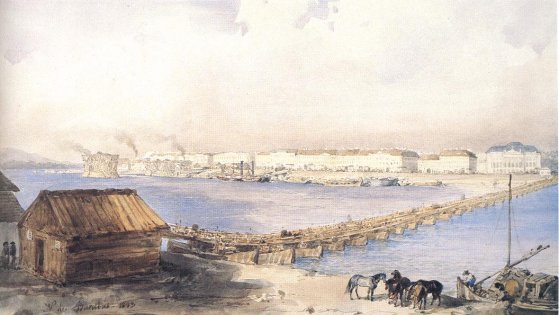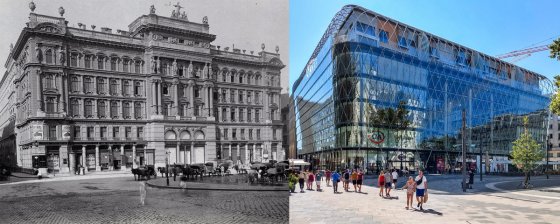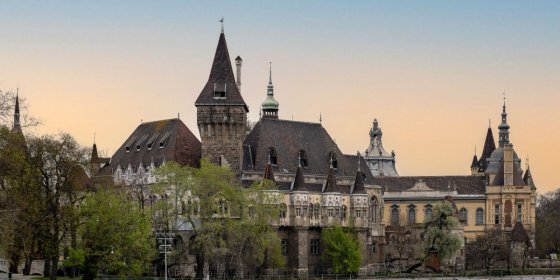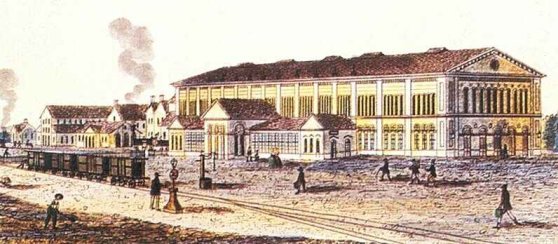 The „intertwined history” of the bridges and the city of Budapest
Which ideas and events have shaped the fate of bridges of Budapest and the cityscape? Alongside many other interesting facts, this question is also answered this newly published book by the Budapest City Archives, which introduces the history of bridges in Budapest.
The „intertwined history” of the bridges and the city of Budapest
Which ideas and events have shaped the fate of bridges of Budapest and the cityscape? Alongside many other interesting facts, this question is also answered this newly published book by the Budapest City Archives, which introduces the history of bridges in Budapest.
histories
 The Pest Zoo opened in the City Park 155 years ago
The Pest Zoo opened in the City Park 155 years ago
August 8, 2021 at 11:30 AM
People have always been curious about special, exotic animals: the stuntmen who appeared in Pest-Buda in the 18th century and travelled with an army of animals have always enjoyed great popularity. However, the real zoo had to wait a long time: it opened its doors on 9 August 1866. The beautiful park quickly became popular among the citizens of Pestbuda, where they could see kangaroos, parrots and reindeers. Giraffes did not arrive at the Zoo until 1868, through the intervention of Queen Elisabeth (Empress Elisabeth of Austria).
István Széchenyi introduced rowing to the Hungarian capital almost 200 years ago
August 7, 2021 at 10:00 AM
At the Tokyo Olympics, Hungarians once again performed very well in water sports, in keeping with tradition. Rowing became established in Hungary thanks to István Széchenyi, who became acquainted with this sport in England. At the end of the 19th century, competitions were held regularly on the Budapest section of the Danube. Moreover, every year since 1925, university sports clubs have compared their skills on the Danube between Margit Island and the main entrance of the University of Technology, thanks to which countless photographs have survived in which we can see the old pre-war city behind the rowers.
An almost concealed plane crash in Budapest - the tragedy in Zugló took place 60 years ago
August 6, 2021 at 3:30 PM
A terrible accident happened 60 years ago in Budapest: a plane crashed into a house in Zugló. The causes of the tragedy, which claimed 30 lives, and the official handling of the accident are more than interesting, as the authorities at the time were trying to cover up the case. Today, however, we know the sad story that put an end to the sightseeing flights over the capital for a long time.
For the first time, we can see in photos what the reborn St. Stephen's Hall looks like
August 6, 2021 at 12:00 PM
For the first time, we can see in photos what the new St. Stephen's Hall in the Buda Castle looks like, which will be opened to the public on 20 August, in two weeks. In the newly taken photographs, we can see several details of the historic ceremonial hall, including the new Zsolnay fireplace, new floor and wall coverings, new pyrogranite images of kings and Hungarian saints, and even a close-up of an armchair and a curtain upholstery.
The Buda Castle under constructionwas also visited by Maria Theresa, who visited the capital in 1751
August 4, 2021 at 3:00 PM
Although she gave permission to expand the Buda Castle, Maria Theresa visited Pest and Buda only twice. Her first visit took place in August of 1751, the 11th year of his reign, 270 years ago. This was when the diet was held in Bratislava and during that time the royal court spent a few days in Pest and Buda.
Life before the Chain Bridge
August 2, 2021 at 9:00 AM
The pontoon bridge between Pest and Buda was built due to the visit of Archduke Albert Casimir and was closed, with a little exaggeration, due to the trip of Count István Széchenyi. The pontoon bridge between the two banks of the Danube was built 255 years ago and was demolished 171 years ago.
The first horse-drawn railway of Pest started 155 years ago
August 1, 2021 at 9:30 AM
On 1 August 1866, the regular services of the city horse-drawn railway started in Pest. The first route led from today's Kálvin Square to Újpest, the journey time was 35 minutes. The new means of transport advocated by Count Sándor Károlyi was successful, and the horse-drawn railway contributed significantly to the development of Újpest. A few years after the handover of the first track, Pest and Buda were almost enmeshed by horse-drawn railway tracks.
Pestbuda recalls how much Budapest has changed in 100 years with 6 interesting pairs of pictures
July 30, 2021 at 9:00 AM
It is always exciting to follow the change, especially when it comes to Budapest. Old photos faithfully document what a house, street or square in the capital used to be like. With their help we can recall the former Haas Palace in Gizella Square, marvel at how - in the 1880s and 1890s - barren the Rózsadomb was, and today's Margit Boulevard were more like the streets of a small town. Factories stood on the banks of the Danube in Pest, next to the Parliament building under construction.
Ferenc Novák designed first an electric cogwheel railway and then a hydraulic funicular on Gellért Hill
July 29, 2021 at 2:00 PM
In the last decade of the 19th century, architect Ferenc Novák presented to the public the plan of the Gellért Hill funicular, which was connected with the intention to demolish the Citadel. According to Novák's idea, not only a funicular would have been built on Gellért Hill, but also a lookout, an illuminated statue and the National Pantheon as a millennium monument. The architect would have built first an electric cogwheel railway and then a hydraulic funicular, for which he also received permits. Yet his dream did not come true.
The Saint Emeric Dormitory in Pest not only provided housing but also raised students
July 28, 2021 at 11:30 AM
At the turn of the century, Saint Emeric's Dormitory was established on a private initiative to alleviate the housing problems of Catholic students and college students, which later developed into a national network. The dormitory operated first in Irányi Street and then on Üllői Road. The Saint Emeric Dormitory in Pest finally found a permanent home under 43-45 Ráday Street in Ferencváros. The renowned dorm suffered from the period of the Hungarian Soviet Republic, but its nearly half-century-old history ended with the turn of the post-World War II era. The building still houses a dormitory.
Vajdahunyad Castle was rebuilt for The Museum and Library of Hungarian Agriculture, founded 125 years ago
July 27, 2021 at 9:00 AM
Vajdahunyad Castle, located on the former Széchenyi Island of the Városliget Lake, has been very popular since 1896. With its special appearance and unique atmosphere, it attracts tens of thousands of visitors. Walking between its walls and characteristic parts of the building, one can travel a long way in time and space from the Highlands to Transylvania, from the Romanesque to the Baroque period. And the walls hide one of Europe’s largest agricultural collections and museums, celebrating its 125th anniversary this year.
Several people have already planned a funicular to Gellért Hill, but neither the cogwheel nor the steam cable car has been built
July 26, 2021 at 2:00 PM
What could be the explanation for the fact that despite the approved plans since the second half of the 19th century, the construction of a Gellért Hill funicular has never started? Guido Fuchs already in 1884, then in the 1890s Mór Balázs, Vince Ede Miller and Ferenc Novák put their own ideas on the table. However, none of them came close to implementation.
The residential house on Rákóczi Road still stands today, the corner of which collapsed 85 years ago
July 25, 2021 at 9:00 AM
A collapsing house in Budapest in 1936 could have caused a huge tragedy. In vain did the residents signal to the owners that the walls were cracking, they did not feel safe, no substantive action was taken. The corner of the house at 73 Rákóczi Road collapsed on 23 July 1936, a few minutes before 3 pm.
The sanctuary of the St. Anne's Church in Batthyány Square was built 275 years ago
July 24, 2021 at 9:00 AM
One of the most characteristic buildings on the banks of the Danube in Buda is the St. Anne's Church in Watertown (Víziváros). The building on Batthyány Square in the 1st District also stands out among the Baroque architectural monuments of the capital. The history of the church dates back to the 18th century, its foundation stone was laid in 1740 and then it was built for a long time. Its sanctuary was built 275 years ago, in 1746, and it was used as a church until the building was completed. On the anniversary, Pestbuda visited the patinated church building of Buda.
Transatlantic pilots were greeted with a huge folk festival in Budapest 90 years ago
July 22, 2021 at 9:00 AM
The people of Budapest did not line up many times to celebrate the heroic deed of the Hungarians on the street. Funerals were unfortunately, more common, but 90 years ago the opportunity was given to celebrate the Hungarians as a hero in a street parade. Namely, György Endresz and Sándor Magyar, who flew across the Atlantic Ocean breaking three world records.
House collapsed in Angyalföld - The tragedy 90 years ago claimed the lives of eight people
July 21, 2021 at 9:30 AM
The whole of Budapest was shaken by the misfortune that took place 90 years ago and claimed the lives of eight workers. During construction, a house collapsed in Angyalföld, Szent László Road.
When the ramp of the Elizabeth Bridge was widened, moving the church also came up, in the end the sidewalk was lowered
July 17, 2021 at 9:00 AM
In the 1930s, the car traffic in Budapest was already so high that the Pest bridgehead of the Elizabeth Bridge had to be rebuilt in order to avoid permanent traffic jams and the risk of accidents. Even the relocation and even demolition of the Inner City Parish Church was discussed, but instead the designers chose an imaginative and inexpensive technical solution. The new ramp of the bridge was completed on 17 July 1936.
A train pulled out of Budapest's first railway station 175 years ago
July 15, 2021 at 9:00 AM
The first station building ('indóház') in Pest was handed over on 15 July 1846, from where the first Hungarian steam-powered train to Vác, which was the first section of the railway line to Vienna, left. With rail transport, the central role of Pest has been strengthened within the country and it set a significant development in motion. So much so that by the 1870s, rail traffic had outgrown Pest's first railway station.
Renowned photographers of the era captured the National Millennium Exhibition in the City Park 125 years ago
July 14, 2021 at 9:30 AM
The National Millennium Exhibition in City Park, opened in 1896, is a unique event to this day. The capital has not hosted such a large-scale exhibition since then, which also presents the history, economy, industry, and ethnography of the nation. Thanks to the photographs taken by the famous photographers of the period, György Klösz and Antal Weinwurm, people can still marvel at the beautiful pavilions built for this event, the ethnographic village, the restaurants and the festive atmosphere.
The Royal Joseph Polytechnic University is 150 years old
July 11, 2021 at 9:00 AM
The history of the Budapest University of Technology and Economics dates back to the 18th century, as one of its predecessors, the Institutum Geometricum, was founded in 1782, while the other, the Joseph College of Technology, was founded in 1844. Yet today's institution, independent and acting as a university on its behalf, was established 150 years ago, in 1871, when the king sanctified the statutes of the university.
From factory to an exciting cultural centre - Millenáris Park is 20 years old
July 8, 2021 at 9:00 AM
Today, Millenáris is a huge park and event centre in Buda, but once the Ganz factory operated here, on the site of which, with the partial retention of the halls, one of the largest cultural centres of Budapest was opened on 6 July 2001.
Many kinds of trams have served Budapest in recent decades
July 6, 2021 at 9:30 AM
UV, ICS, Bengali, CAF, Combino, Hanover - these trams have defined tram transport in Budapest in recent decades. Now more CAF products are in service, but take a look at what kind of trams the people of Budapest used and what do these weird names mean?
Once upon a time there was the Amusement Park - In the early 1800s, the former 'Vurstli' settled in the Városliget
July 4, 2021 at 9:30 AM
The history of the former Amusement Park of Budapest dates back a long time: performers in Városliget entertained the population of the capital since the beginning of the 19th century. The Vurstli, the Ős-Budavár, the Angol Park, and from 1950 the Amusement Park of Budapest were all created to entertain people. The Amusement Park, which has had several golden ages, was finally closed in 2013, and in its place the Holnemvolt Vár can now be seen and the Pannon Park is being built, which will perhaps restore the atmosphere of the former entertainment district.
Reporting infectious patients was ordered 140 years ago in Budapest
July 3, 2021 at 9:00 AM
Diseases and epidemics are part of our history, as we have seen in the last year and a half. In the XIX. century people began to recognize how each disease spreads and how to prevent them. The new epidemiological rules came into force in Budapest 140 years ago, on 1 July 1881. The obligation to report, and quarantine still helps to control epidemics today.
The unified ticket and pass system was introduced in public transport in Budapest 55 years ago
July 1, 2021 at 9:00 AM
By the mid-1960s, there were already 130 types of tickets for transport companies in the capital. The system was non-transparent, and the companies had much less revenue from tickets than the cost of operating the system. Therefore, a new fare system was introduced in Budapest on 1 July 1966, which has actually survived to this day.
Flórián, the first real shopping centre in Hungary, opened 45 years ago
June 29, 2021 at 9:30 AM
The Flórián shopping centre, then officially called Óbudai Centrum Department Store, was the first real shopping centre in Hungary. The building was handed over 45 years ago. It was built to serve the housing estate of Óbuda and North Buda, and it was so important that even the Roman ruins found here, the remains of the command building of the former legionary camp were sacrificed for it.
The first Hungarian Grand Prix in Népliget, held 85 years ago, was a huge sports success, but a commercial failure
June 27, 2021 at 9:00 AM
The most prestigious car race today is Formula 1, which has had races in Hungary since 1986. However, 50 years before Formula 1, in 1936, a Grand Prix was held in Hungary, namely in Népliget. The competition was successful from a sports standpoint, but a commercial disaster.
Budapest then and today – 5 photos showing how much the city has changed over a century
June 24, 2021 at 9:00 AM
Comparing past and present is always exciting. Walking around the city, one can often wonder what this or that street used to look like, what houses stood, and which were built later. If someone looks at an archive picture, the old buildings that still stand today, such as the Parliament or the St. Stephen's Basilica, help them find their way. At the same time, they can admire the once small-town atmosphere of Csalogány Street, the almost unrecognisable Deák Square or the old Erzsébet Bridge that many still consider to be one of the most beautiful bridges built in Hungary.
Only one-third of the apartments in Budapest had bathrooms in the 1930s
June 20, 2021 at 12:00 PM
In the first half of the 19th century, the facilities of apartments in Budapest did not even come close to what is usual today. According to statistics from 1930, 23 per cent of homes did not have plumbing, only a third had a bathroom, and just over half had a toilet.
Széll Kálmán Square became a transport hub 80 years ago
June 18, 2021 at 9:30 AM
There was once a clay mine and then a sports field on the site of today's Széll Kálmán Square, where the tram junction and the pedestrian overpass, which defined the image of "Kalef" for decades, were completed 80 years ago, in June 1941. Then, in the middle of the square, a roundabout was created for trams, from where vehicles could depart in all directions. Modern passenger waiting areas and bus terminals were also built, but the development did not fully win the favour of the contemporary public.
More articles
 The „intertwined history” of the bridges and the city of Budapest
Which ideas and events have shaped the fate of bridges of Budapest and the cityscape? Alongside many other interesting facts, this question is also answered this newly published book by the Budapest City Archives, which introduces the history of bridges in Budapest.
The „intertwined history” of the bridges and the city of Budapest
Which ideas and events have shaped the fate of bridges of Budapest and the cityscape? Alongside many other interesting facts, this question is also answered this newly published book by the Budapest City Archives, which introduces the history of bridges in Budapest.
 The Bridge Report, which brought a turning point in the history of Budapest
A travel report that changed the history of Pest and Buda, as well as Hungary. The little book contributed to the change of half a thousand years of legal customs and the implementation of an investment of unprecedented size and technical quality. This book was The Bridge Report [Hídjelentés in Hungarian].
The Bridge Report, which brought a turning point in the history of Budapest
A travel report that changed the history of Pest and Buda, as well as Hungary. The little book contributed to the change of half a thousand years of legal customs and the implementation of an investment of unprecedented size and technical quality. This book was The Bridge Report [Hídjelentés in Hungarian].
 Drama on the university wall - The heroic monument was planned 95 years ago
In the constant hustle and bustle of the Egyetem Square in Pest, the students may not even notice the monument that decorates the short section of wall between the church and the central building of ELTE. However, it commemorates their predecessors, the heroes who fought for their country in World War I, and those who heroically helped them. The first design of the dramatically collapsing soldier was born in 1928, ninety-five years ago.
Drama on the university wall - The heroic monument was planned 95 years ago
In the constant hustle and bustle of the Egyetem Square in Pest, the students may not even notice the monument that decorates the short section of wall between the church and the central building of ELTE. However, it commemorates their predecessors, the heroes who fought for their country in World War I, and those who heroically helped them. The first design of the dramatically collapsing soldier was born in 1928, ninety-five years ago.





























